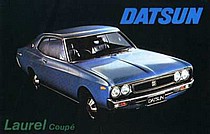
In April 1972 the second Laurel generation appeared, again in four-door saloon and two-door hardtop coupé form affectionately known as the Butaketsu Laurel (“pig butt”) because of its ample rear quarter panels and tail section, with the taillights incorporated into the rear bumper. The saloon now was endowed with a rear beam axle and leaf springs, while the coupé clung to independent rear suspension.
In addition to the 1.8 and 2.0 L four-cylinder engines, a 2.0 L inline-six was now available, joined, from October, 1973, by a 2.6 L six; the latter was replaced by a 2.8 L six in late 1975. The G-20 4-cylinder and L20 six-cylinder engines were equipped with SU twin carburetors but were eliminated February 1976 due to emission regulations.
The styling of the coupe appears to be influenced by the 1970 Ford Torino and the 1971 Mercury Cougar, reflecting a popular styling trend during the 1960s and 1970s called “coke bottle”. Sales in Japan (very few were exported) ran to about 96,000 per year, with three-quarters sedans. The Toyota competitor was the Mark II coupé and sedan.
Datsun 200L sedan (Europe)
Engines available at the time were the four-cylinder 1815 cc G18 and 1990 cc G20, and the six-cylinder 1998 cc L20. Both the G20 and L20 were available with twin SU carburettors as an option. However, only the G20 equipped cars outwardly announced this with a “Twin Carburettor 2000GX” badge.
In October 1973 the first Laurel with the 2565 cc L26 six-cylinder engine was added and badged as “2600SGL”. Since the engine was over two litres, it was not restrained by the size limits imposed by Japanese regulations, and therefore it was fitted with bigger bumpers than regular Laurels. The installation of the 2.6-litre engine in Japanese models helped identify this generation as a luxury car, as the larger engine obligated Japanese drivers to pay higher amounts of annual road tax.
In September 1975, in order to meet the new emissions regulations for that year, the L26 was replaced by the larger yet 2753 cc L28 six-cylinder. By October the carburettors in the L20 were replaced with electronic fuel injection and the engine was now dubbed L20E. Because of the difficulty in meeting the emissions regulations, the twin-carburetted engines were all discontinued. The 1,770 cc L18 replaced the G18 in the lineup.
In February 1976 carburetted 1.8-litre and 2.0-litre engines which met the 1976 emissions regulations were introduced, and were identified with the Nissan NAPS badge.
Nissan Laurel 2000SGX Hardtop (C130) with non-standard wheels
Laurel C130-EV
In 1974 Nissan developed an electric passenger sedan based on the Nissan Laurel. The Nissan Laurel C130-EV – referred to as the Datsun 200L-EV in export markets – developed to be used by the VIPs at the 1975 International Oceanographic Exposition in Okinawa. It was originally engineered by the Prince Motor Company, but produced by Nissan when the company assumed Prince operations in 1966.
The C130-EV uses one 16.0 kW (21.5 hp) electric motor, rear-mounted and driving the rear axle through a two-speed automatic transmission. The Nissan Laurel C130-EV has a claimed top speed of 85 km/h (53 mph) and a range of 65 km (40 mi). Nissan’s next electric car venture would be the 1998 Altra.
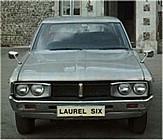
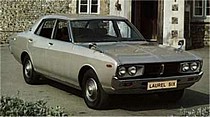

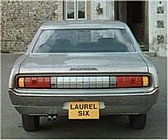
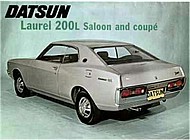
Also called Datsun Laurel, Datsun 200L
Chassis code: C130, KPC130
Assembly Musashimurayama, Japan
Designer Shinichiro Sakurai
Body style 2-door hardtop coupé, 4-door sedan
Layout front engine/rear driveEngine
1770 cc L18 I4
1815 cc G18 I4
1990 cc G20 I4
1998 cc L20A I6
2565 cc L26 I6
2753 cc L28 I6
Induction motor (EV)
Transmission 4,5-speed manual, 3-speed automatic
Dimensions
Wheelbase 2,670 mm (105.1 in)
Length 4,500 mm (177.2 in)
Width 1,670 mm (65.7 in)
Height 1,415 mm (55.7 in)
Curb weight 1,155 kg (2,546.3 lb) 1,919 kg (4,231 lb) (EV)
![]()